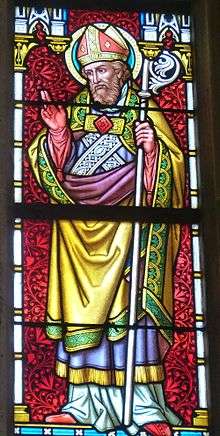Altmann, Bishop of Passau

Altmann von Passau (* around 1015 in Westphalia, 8 August 1091 in Zeiselmauer, Lower Austria) was an important representative of the Gregorian reforms, bishop of the diocese of Passau, monastery founder and reformer, who was revered as a saint.[1][2]
Life
He was born between 1013 and 1020, came from the Old Saxon aristocracy, visited the cathedral school of Paderborn and later became its leader. He was from about 1056 to 1065 propst at the Aachen Marienstift, also Hofkaplan of Emperor Heinrich III. And canons in Goslar.
In 1065 he became bishop of Passau and began the reform of the clergy. He founded Abbey of St. Nikola in Passau (1070) in Passau and Göttweig (1083) in Lower Austria, which was converted into a Benedictine monastery in 1094.
He was at the time of the investiture controversy, on the side of Pope Gregory VII., Proclaimed his Reform Decree in 1074 and was the most zealous promoter of the Church reform in the German lands. [4] In 1076, as well as the Archbishop of Salzburg, Gebhard von Helfenstein (who had consecrated Altmann as a bishop), he did not take part in the court day of Worms and supported the counter-king Rudolf von Schwaben. He was expelled from Passau by Emperor Henry IV, who devastated this city in 1077/1078. The princely rights over the town of Passau were lost, the king lent them to the Burggrave Ulrich, whom he had employed. These were to be returned to the bishops only after the death of the Burggrave in 1099.
Altmann took part in the Fastensynodes 1079 and 1080 in Rome. He was appointed papal Vicar for Germany and was able to win the Margrave Leopold II of Austria for the Pope's party. In 1085 he was deposed by the Emperor as a bishop of Passau, and he usually stayed in the territory of the Austrian margrave, where he reformed the existing monasteries of St. Florian, Kremsmünster, Melk, and St. Pölten, improved the parish church organization and built stone churches. His influence on the government of the margraviate was at times so high that he was called the "leader" of Margrave Leopold II. [4] and was buried in the monastery Göttweig. He is venerated as a saint, although no official canonization has taken place.
References
- ↑ Egon Boshof: Altmann von Passau. In: Lexikon der Heiligen und der Heiligenverehrung. (A–H) 1. Band. Herder, Freiburg i. B. 2003, ISBN 3-451-28191-0
- ↑ J. Oswald: Altmann. In: Lexikon für Theologie und Kirche. 2. Auflage, 1. Band. Herder, Freiburg i. B. 1957.
- ↑ Andreas Seidler: Altmann von Passau. In: Michael Buchberger (Hrsg.): Lexikon für Theologie und Kirche (LThK). 1. Auflage. Band 1. Herder, Freiburg im Breisgau.
- 1 2 Floridus Röhrig: Leopold III. der Heilige Markgraf von Österreich. Verlag Herold, Wien-München 1985. ISBN 3-7008-0290-0, p21